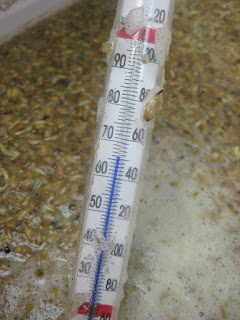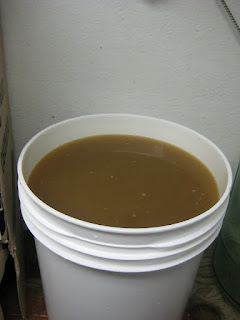It has been a long time since I have posted, I have been very busy and I have also stopped posting recipes, because I am now creating my own. It is difficult to squeeze in a brew day as I need a good four hours for an all grain brew. I also have moved the brewery to the garage......
Potential new T-Shirt?
Here is a brew-by brew update of where I am right now.
Moonstone Pale Ale -
Brewed: July 21st, 2010
Racked to Secondary: August 1st, 2010
Bottled: August 19th, 2010
OG: 1047 FG: 1010 ABV: 5%
This beer was my first all grain brew and I tried to keep it simple .... The brew day post can be found
here. I was using a new brew pot and later discovered that I was not lighting the burner properly, therefore could not keep a steady boil. When I transfered this beer to the secondary, I noticed it was very cloudy.... at this point I was worried, without a full proper boil, I had run the risk of contamination and improper bitterness extracted from the hops. This was not my main concern as the cloudiness was really bothering me... I tried to clear the beer by crash cooling it, I placed the entire carboy in my garage fridge.
Crash cooling meant I had to sacrifice fridge space of drinkable brew. Thankfully I have four fridges.
The Crash Cooling seemed to have no effect, so I bottled it anyway. After three weeks of carbing and conditioning, the beer poured cloudy, had an aroma of vegetables, and tasted like shit. I tried cold conditioning some bottles for several weeks with no improvement...... until today. I poured a glass of warm Pale Ale to snap a picture of its cloudiness for this blog, to my surprise, after 6 weeks in the bottle, it had cleared. I took a sniff and was surprised that it smelled like beer instead of vegetables. I have placed four bottles in the fridge for a taste test, I will update with my results.
After six weeks of bottle conditioning, it actually looks drinkable.....
Moonstone Heffeweizen-
Brewed: August 12th, 2010
Racked to Secondary: August 19th, 2010
Bottled: September 1st, 2010
OG: 1070 FG: 1012 ABV: Unknown (read below for explanation)
This was my second attempt at an all grain brew and this Heffe was brewed according to the Bavarian Law of Purity containing just four ingredients, malted barley, water, hops, and yeast. To keep it real, I even used nothing but 100% German ingredients (except for Moonstone water) and this beer was also my first time using a liquid yeast. Many beers can be brewed with common neutral yeasts, however some styles receive a lot of characteristics acquired from the yeast strain. For this Heffe I used a yeast from the Weihenstephan strain, which is the most common yeast strain used by German brewers ... this yeast can exhibit a clover and banana smell which came through very strong on this beer. This is also a wheat beer, therefore using a wheat yeast with wheat malts will retain some of the yeast in suspension for a cloudy appearance.
Liquid Yeast
After the brew when the wort was poured into the primary fermenter I noticed the level was very low, I took a gravity reading and was shocked to see I overshot it by a lot .... The OG reading was 1070, obviously my water to grain ratio was way off. Also, adding to the problem was the fact that I mashed for 90 minutes rather than the previous brew mash of 60 minutes. Perhaps I shouldn't be experimenting so much on just my second all-grain brew. When the beer was racked to the secondary the hydrometer showed the final gravity to be 1012, this would translate into an ABV of 7.8% which is way too high for this beer style. I boiled some water to sterilize it and topped off the carboy. The evidence of this watering down shows through on the final beer.
Moonstone Heffeweizen after a few weeks in the bottle
Moonstone Heffeweizen today
It is very hard to screw up a beer, and although this beer is still very nice, my mistakes are definitely noticeable. Because it was watered down, the mouth feel and body is much lighter when consumed beside a real German Heffe, I have since dialed in my water to grain ratio and will correct this next time. The banana smell from the yeast is very strong which means I need to ferment at a slightly higher temperature next time, and even though it was watered down , this beer still has a strong alcohol taste and is much stronger than it should be.
Moonstone Amber Ale-
Brewed: August 20th, 2010
Racked to Secondary: August 30th, 2010
Bottled: Sep 13th, 2010
OG: 1052 FG: 1010 ABV: 5.7%
My Rusty Cap Red was an extract brewed amber ale and was a huge success. I decided to convert this to an all grain recipe and I wanted it to be all mine. I used a base recipe for the extract version and accidentally created my own hop schedule due to the fact that I didn't have the proper quantities on hand when the wort was boiling. Since I now had my own hop schedule, I just needed the grain bill ... I decided to read about Amber Ale and it's style guidelines and came up with my own recipe. I brewed it up and even tossed in a touch more centennial hops at the end of the boil for some added aroma. This beer has aged for three weeks and I sampled a few last week at around the 2.5 week mark .... the carbonation isn't yet where I would like it and there is a very nice strong hop taste and aroma that I expect to mellow out in another week or so. I am going to take a break from writing this to go pour one now and snap a picture. ...........

Moonstone Amber Ale ... why do we have so many apples?
Ahhhhhhh ..... wow, its good. It still will benefit from some further bottle conditioning and some cold conditioning. I like it where it is now, but it will appeal more to others once the hoppy-ness mellows slightly.
I have two more brews on the go right now, they are two specialty beers that I have done for the fall and winter season. The first one, which I hope will be ready for Halloween, is a Pumpkin Ale brewed on September 16th with pumpkin, nutmeg, and cinnamon. It was bottled this evening and it already smells and tastes amazing....... pumpkin pie in a glass is the best way to describe it. Despite all the added stuff that went in the brew pot, this one was very clear when bottled. This one comes in at an ABV of 5.6% - I will scale back my grain bills slightly in the future to try and get closer to 5%.
Pumpkin Ale bottled
Moonstone Pumpkin Ale showing a very nice clear orange color.
A certain friend of mine loves Scotch Ale, and even though I am not a huge fan, I have brewed one up that I hope will be ready for Christmas. Moonstone Wee Heavy was brewed on September 27th and is still chugging away in the primary, this is the slowest fermentation I have ever experienced. The original gravity was 1074 and I took a reading today and it is only sitting at 1030, it still has a way to go. My target ABV is around 8% which would make it correct for the style as Wee Heavy's are typically higher than 7% ABV. This beer will need to spend around one month in the secondary fermenter to age properly and another 2 months in the bottle which will make this strong beer ready for Christmas.
Moonstone Wee Heavy in the primary fermenter.
Well, that is where the brewery sits today, up next will be a second attempt at the Pale Ale with a proper boil, and I need to come up with an all grain recipe for my Chocolate Stout. i would like to get these two brewed before the deadly Moonstone winter hits and my passion for brewing is crushed by 10 feet of snow and -50 wind chills...... As for brewery upgrades, I would love to move my operation 100% to the garage, which means adding a sink and plumbing as well as a temperature controlled fermenting closet. I also would like to start kegging but cannot afford the investment at this point ..... the ONLY thing I do not enjoy about brewing is the bottling. Keep posted for the birth of Moonstone Farms this spring as I will be attempting to grow my own hops in the back yard.















































